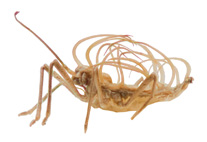Abstract
Very little information exists relevant to the species grouping and phylogenetic relationships of the opossum genus Mono-delphis Burnett. Of the clearly distinct named species, the least information is available for M. unistriata (Wagner), one of the world’s most poorly known species of mammals. Extant specimens consist of the Brazilian holotype of a skin now without a skull and dating from almost 200 years ago, and a second specimen with skin and incomplete skull dating from over a hundred years ago and from Argentina. The most recent published notes on the holotype date from well over half a century ago and, all told, such notes, the earliest dating from 1842, add up to a highly fragmentary and contradictory picture. No observations whatsoever have ever been published for the second and more complete specimen. Also, no hy-potheses have ever been made concerning the intrageneric affinities of M. unistriata and such affinities have also been obscure throughout the genus. Herein, we provide a detailed redescription of M. unistriata, the first published images of specimens, and the first account, beyond the previous few most vague and incomplete remarks, of the morphology of the skull. In an effort to ascertain the phylogenetic affinities of M. unistriata, we performed a combined molecular (cyto-chrome b) and nonmolecular (postcranial, cranial, integument, and karyotypic characters) parsimony analysis incorporat-ing 27 species of didelphids, including 11 of Monodelphis. Our results strongly support the monophyly of Monodelphis, and place M. unistriata as sister group to M. iheringi, among the included species.

